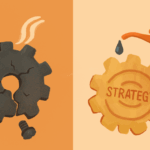Like so many things in higher ed marketing—marketing generally, but also in life—there’s an art and a science to getting people to open up. The same holds for getting people to open up their checkbooks and give.
The Science Behind Philanthropy: Eight Drivers of Giving
Suppose we double-click into the ‘science’ side of things (as our academic tendency might be) and look at empirical studies on philanthropy, there are eight identified drivers of charitable giving. These range from baseline awareness and actual solicitation to tangible and/or psychological cost benefits and social reputation consequences, as well as more redeeming philanthropic motivators like altruism and values alignment.
Why Emotional Engagement Should Be the Ninth Driver
And although eight is a nice round number and likely more than enough impetuses to consider, I’d like to suggest a ninth: emotional engagement.
There’s scientific backing for the correlation between emotional engagement and enhanced giving. The part of the human brain that’s responsible for processing altruism is the very same part of the brain that’s responsible for processing emotions like nostalgia.
Nostalgia: A Powerful Tool for Higher Ed Fundraising
Higher ed marketers, and surely higher ed fundraisers, can attest to the notion that nostalgia is an effective doorway in the fundraising process.
Now, here’s where the ‘art’ side of things comes in. Storytelling is an incredible mechanism to achieve emotional resonance.
The Art of Storytelling: Creating Emotional Resonance
This isn’t a novel concept, per se; storytelling has always been a huge part of the human experience. But at a time when attention spans are increasingly splintered and society seems (or is) increasingly fractured, stories have the potential to be unifying and universally transcendent—across socioeconomic standing and political stances and, presumably more easily, across class years and disciplines of study.
The greats will tell you as much. Does Andrew Stanton ring a bell? You might not immediately know his name, but I guarantee you know his stories. He’s the filmmaker behind all the Toy Story movies, Finding Nemo, Wall-E, Monsters Inc., and more—you know, those made-for-kid movies that always make adults tear up.
He maintains: “We all love stories. We’re born for them. Stories affirm who we are. We all want affirmations that our lives have meaning. And nothing does a greater affirmation than when we connect through stories. It can cross the barriers of time, past, present and future, and allow us to experience the similarities between ourselves and through others, real and imagined.”
From Transactional to Transformative: The Role of Stories in Donor Relationships
If you buy into Stanton’s idea (and it’s a pretty compelling one), then stories are, in essence, the great equalizer. Stories are also a great emotion catalyzer if you buy into my idea.
So then if we take it back to a fundraising place, storytelling can cut across geographical and generational divides, connect deeply and meaningfully with audiences, and be the bridge from transactional donor relationships to transformative partnerships.
In today’s development landscape, we know that it’s not enough to simply communicate tangible university needs, and it’s not realistic to expect donors to write checks solely based on ‘engaged alumni’ status. Big donors want to connect on values and back new, big ideas, and storytelling can most effectively fold them into an institutional vision and invite them into an impact narrative.
Balancing Authenticity and Aspiration in Fundraising Narratives
Major caveat: emotional engagement is not code for contriving elaborate stories for donors. There’s no extra credit for manufacturing something that sounds intriguing but stretches the truth. You lose points for that; you lose credibility.
The key is to marry authenticity with aspiration in storytelling. To highlight real scenarios that tug at the heartstrings—and eventually the purse strings—because of how earnestly stories are conveyed; how informative and educational story arcs are, while also inspiring involvement; and how easily donors can envision a singular story unfolding at scale. It’s an awesome balancing act of building a rational case for support and delivering higher-order emotional benefits.
Now, marketer to marketer, a story’s emotion-to-action conversion rate is oftentimes less about exact details and more about what or how the audience feels overall. I don’t know if I’d tell Mr. Stanton that (at least not in so many words), but you know, he’d probably get the gist.
Newsletter Sign up!
Stay current in digital strategy, brand amplification, design thinking and more.




